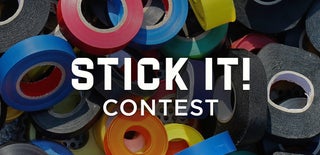Introduction: Tape Times Two: Tile Tutorial
Use car detailing tape to decorate your own handmade tiles and affix them to a wall using picture mounting tape.
If you like this instructable please vote for it at the "Stick it" contest :)
Step 1: HOW Did This Start?
I wanted a piece of art to decorate an empty wall in my office. Since I do not own the space, I had to make sure I was following the rules. I did some research and learned that I was not allowed to use nails or damage the walls and/or paint in any way so I decided to use Command mounting strips as they are easy to remove without damaging the wall.
Since these strips can hold a limited amount of weight, I planned to make mural composed of ceramic tiles. Although the whole mural itself is heavy, individual tiles are be pretty light and I could stick them to the wall using one mounting strip for each tile.
Step 2: WHY This Design?
I particularly like hexagons and they are quite popular in modern design. Additionally, I like the fact that they can be used to build tessellations (in other words, they can cover a surface with no gaps or overlapping between adjacent tiles). So hexagons it is!
Initially, I thought about making plain hexagons of two different sizes, just glaze them in different colors and lay them out randomly but... why keep it simple when I can make it more complicated? Then I decided to make the mural so that each tile was "one-of-a-kind"
Step 3: WHO Can Complete This Project?
Anyone having has access to a kiln can complete this project. However, owning a kiln is not required. In fact, I don't own a kiln but I get my pieces fired at a community studio where I take classes. Even if you do not want to take a ceramics class, many studios will fire your pieces and charge you by the the piece or by volume.
Also, time and patience are crucial for successful completion of this project.
Step 4: WHAT Is Needed?
- Block of clay. It is quite tricky to make flat thin objects with regular stoneware clay because they tend to warp when they are fired. As an alternative, I used paper clay, which is far more forgiving. Making paper clay at home can be a challenge, so I bought it mixed and ready to use from Laguna.
- Slab roller or rolling pin.
- Clay tool kit. You can get very inexpensive kits that will last for years. For this project I only used a sponge, a metal rib (or you can use an old credit card or similar flexible material) and a knife.
- Hexagon templates. I got hexagon templates designed for quilting, but you can make your own using cardboard or transparency film. Remember to make REGULAR hexagons. For instructions on how to draw a regular hexagon go to the following link (use method 1).
- Pencil.
- Ruler.
- Compass (the kind you use to draw circles).
- Pinstriping tape. Also known as tape for fine masking, or car detailing tape (I get mine online).
- Exacto knife and blades. I use heavy duty blades as the regular ones get dull in no time.
- Ceramic glazes. For this project I used cone 5/6 Amaco glazes: Oatmeal, Temmoku, Tourmaline, Art Deco Green and Satin Matte Teal.
- Brushes. I use thin soft art brushes (any brand will work, I got the ones that were on sale).
- NIOSH-certified respirator for thin particulates. This is very important. One of the steps in this technique involves removing the masking tape form the glazed tiles. This process causes small pieces of dry glaze to break, releasing very small dust particles that can hurt your lungs. They are invisible but dangerous and can stay floating in the air for days, so I always peel off the tape outside wearing my respirator. I also change the filters as indicated by the manufacturer to make sure I am always protected.
Step 5: HOW Is It Made?
Follow the instructions in the video.
Remember to apply three coats of glaze (I only show one in the video).
Instructions to use the mounting strips are not included in the video, but you can download them from the manufacturer's link. I used only one strip per tile.
Step 6: WHEN Is the Best Time to Start This Project?
There's no better moment than the present. What are you waiting for?...
... and remember this is only one example, the forms, patterns and color combinations you can create using this technique are endless.
HAVE FUN!

Participated in the
Stick It! Contest











